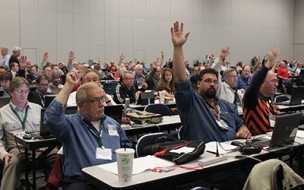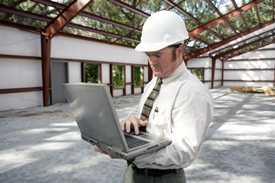Who remembers logging onto AOL using the old dial-up modems? I am sure you can hear it now. It seemed like a good idea at the time and got the job done, but in in retrospect, the process seems comically slow and inefficient. You could say the same about the state of the model building code development process.
 The process used to require code officials to commit to a lengthy and expensive pilgrimage to code-geek Mecca: the International Code Council’s Public Comment Hearings. These annual hearings are where code officials gather to spend up to 12 hours a day, for up to a week, locked in a steely, fluorescent-lit conference room voting on changes to the model code. And those are just the officials who care!
The process used to require code officials to commit to a lengthy and expensive pilgrimage to code-geek Mecca: the International Code Council’s Public Comment Hearings. These annual hearings are where code officials gather to spend up to 12 hours a day, for up to a week, locked in a steely, fluorescent-lit conference room voting on changes to the model code. And those are just the officials who care!
This year, however, we usher in a new way of doing things: cdpACCESS. This is a biggest change in U.S. building codes since the Triangle Shirtwaist Factory fire of 1911.
The reason this is such a big deal is that it is a change in process. It’s more than just a typical, hotly contested code change proposal—whether to add residential sprinklers or not, increase R-Values, Solar Heat-Gain Coefficients—it is a complete tectonic shift in who participates in the code development process and how they participate. The new protocol will completely democratize the process, enfranchising tens of thousands of code officials.
The old way of doing things required code officials to be at the hearings, in person, in order to vote on code change proposals. This often meant missing up to a week of work and paying exorbitant travel costs (often during an era of travel freezes). The shortcomings of the development process up until now has fostered a number of problems, not the least of which has been the disenfranchisement of smaller jurisdictions who can’t afford the lost productivity of absent code officials or the travel costs. No matter how interested or well intentioned the average code official was, it often wasn’t feasible for them to attend.
 For the first time, code officials from across the country will be able to cast their votes on code change proposals right from their computers—at home, at the office, or along with coworkers—wherever and whenever is most convenient for them. They will also be able to make better-informed decisions, with the opportunity to review numerous resources and expert testimony, without being subject to a time limit. These changes don’t just remove barriers to entry; they crush them.
For the first time, code officials from across the country will be able to cast their votes on code change proposals right from their computers—at home, at the office, or along with coworkers—wherever and whenever is most convenient for them. They will also be able to make better-informed decisions, with the opportunity to review numerous resources and expert testimony, without being subject to a time limit. These changes don’t just remove barriers to entry; they crush them.
Code hearings often have as little as 100 participants. We need to make that 10,000.
There are few examples in the construction arena that can match the stakes of model code development. There is a lot on the line for product manufacturers, home builders, code officials, and consumer advocates; the process is surprisingly political. Previously, the cities that could afford to send delegates were lobbied hard for their acceptance of code change proposals. cdpACCESS levels the playing field by making sure that every code official has the opportunity to vote.
One unintended consequence of the old way of doing things is that code officials in small towns across the country began feeling the code didn’t belong to them, that the codes were being promulgated by the big cities of the east and west coasts. By feeling left out and disenfranchised, they grew a lack of will to enforce the codes, particularly the building energy code.
cdpACCESS gives the opportunity to engage these code officials in the pursuit of building safer, energy efficient, and resilient communities—and that is the reason why I am so excited about this change. It presents the opportunity to bring tens of thousands of code officials to the table and participate in a process where the end result affects every single person.
But we shouldn’t stop there and we shouldn’t be shortsighted. cdpACCESS gives us a chance to start over, not just to pass or defeat a single code change proposal, but to consider some major issues facing the codes world, such as:
- In a recent survey conducted by ICC and the National Institute of Building Sciences, over 80 percent of code officials expect to retire in the next 15 years. How can we use cdpACCESS to attract and engage the next generation of code officials?
- How can we use this new tool to engage more code officials on issues of compliance and enforcement?
- How can we leverage the new system to further advance market transformation in building energy codes?
- How can we, as a community, use this tool to gain more building energy efficiency advocates in unexpected places?
The answers to these questions, and many others, will come in many forms. But there’s one thing we know right now: We need smart people with big ideas.
*A schedule of free cdpACCESS webinars can be viewed at www.iccsafe.org/cdpACCESS. To see answers to questions about cdpACCESS, go to www.iccsafe.org/cdpACCESSQA.